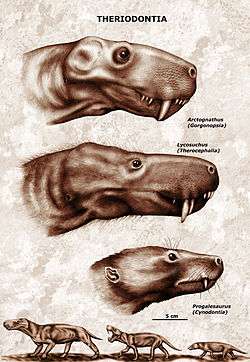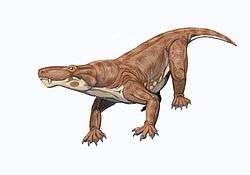Theriodont
| Theriodonts Temporal range: Middle Permian–Present, 265–0 Ma | |
|---|---|
 | |
| Scientific classification | |
| Kingdom: | Animalia |
| Phylum: | Chordata |
| Order: | Therapsida |
| Clade: | Neotherapsida |
| Clade: | Theriodontia Owen, 1876 |
| Groups | |
Theriodonts ("Beast Tooth", referring to more mammal-like teeth), are a major group of therapsids. They can be defined in traditional, Linnaean terms, in which case they are a suborder of mammal-like reptiles that lived from the Middle Permian to the Middle Cretaceous, or in cladistic terms, in which case they include not only the traditional theriodonts but also their descendants the mammals as well (in the same way that, cladistically speaking, the theropod dinosaurs include the birds as a sub-clade).
Theriodonts appeared almost the same time as the anomodonts, about 265 million years ago, in the Middle Permian. Even these early theriodonts were more mammal-like than their Anomodont and Dinocephalian contemporaries.
Theriodonts fall into three main groups: Gorgonopsia, Therocephalia and Cynodontia. Early theriodonts may have been warm-blooded. Early forms were carnivorous, but several later groups became herbivorous during the Triassic.
Theriodont jaws were more mammal-like than was the case of other therapsids, because their dentary was larger, which gave them more efficient chewing ability. Furthermore, several other bones that were on the lower jaw (found in reptiles), moved into the ears, allowing the theriodonts to hear better and their mouths to open wider. This made the theriodonts the most successful group of synapsids.
Eutheriodonts refer to all theriodonts except the gorgonopsians (the most primitive group). They included the therocephalians, cynodonts and their descendants - the mammals . The name means "true beast tooth". The eutheriodonts have larger skulls, accommodating larger brains and improved jaw muscles.
The theriodonts (eutheriodonts) are one of the two synapsid survivors of the great Permian–Triassic extinction event, the other being the dicynodonts. Therocephalians included both carnivorous and herbivorous forms; both died out after the Early Triassic. The remaining theriodonts, the cynodonts, also included carnivores, such as Cynognathus, as well as newly evolved herbivores (Traversodonts). While Traversodonts for the most part remained medium-sized to reasonably large (the length of the largest species was up to 2 meters), the carnivorous forms became progressively smaller as the Triassic progressed. By the Late Triassic, the small cynodonts included the rodent-like tritylodonts (possibly related to or descended from traversodonts), and the tiny, shrew-like, trithelodonts, which evolved into the first mammals. The trithelodonts died out during the Jurassic, and the tritylodonts survived into the Cretaceous, but the mammals continued to evolve. Many mammal groups managed to survive the Cretaceous–Paleogene extinction event, which wiped out the non-avian dinosaurs, allowing the mammals to diversify and dominate the Earth.
Taxonomy
Classification
- Order Therapsida
- Theriodont *
- Suborder †Gorgonopsia
- Family †Gorgonopsidae
- Eutheriodontia
- Suborder †Therocephalia
- Family †Lycosuchidae
- (unranked) †Scylacosauria
- Family †Scylacosauridae
- Infraorder †Eutherocephalia
- Family †Hofmeyriidae
- Family †Moschorhinidae
- Family †Whaitsiidae
- Superfamily †Baurioidea
- Family †Bauriidae
- Family †Ericiolacteridae
- Family †Ictidosuchidae
- Genus †Ictidosuchoides
- Genus †Ictidosuchus
- Family †Ictidosuchopsidae
- Family †Lycideopsidae
- Suborder †Therocephalia
- Suborder †Gorgonopsia
- Theriodont *
Phylogenetics of Theriodontia from Tree of Life (www.tolweb.org)
- Therapsida
- Mammals and extinct relatives
- †Biarmosuchia
- †Eotitanosuchia
- †Dinocephalia
- †Anomodontia
- Theriodontia
- †Gorgonopsia
- †Therocephalia
- Cynodontia
- †Diviniidae
- Mammalia
- †Procynosuchidae
- †Galesauridae
- †Thrinaxodontidae
- †Cynognathidae
- †Gomphodonts
- †Chiniquodontidae
- †Probainognathidae
- †Tritheledontidae (Ictidosauria)
See also
External links
- Theriodontia - at Paleos
